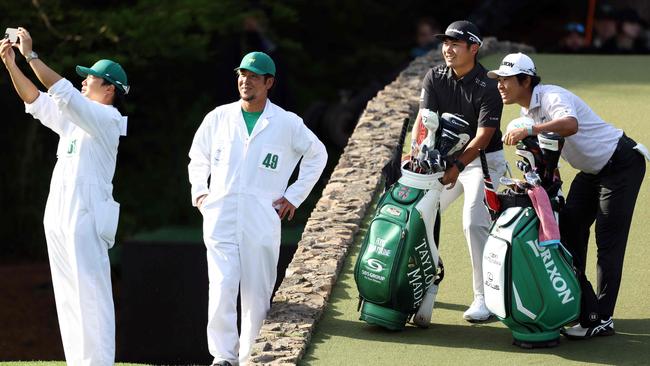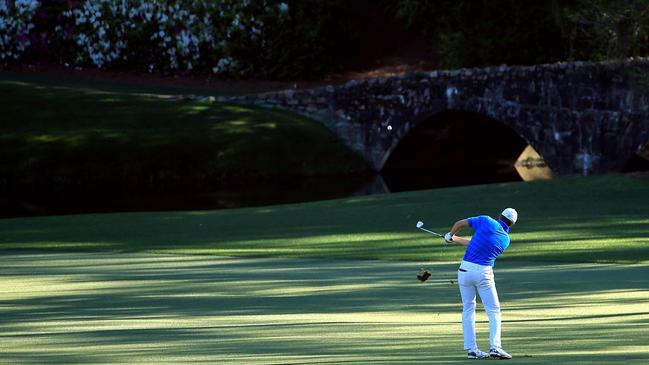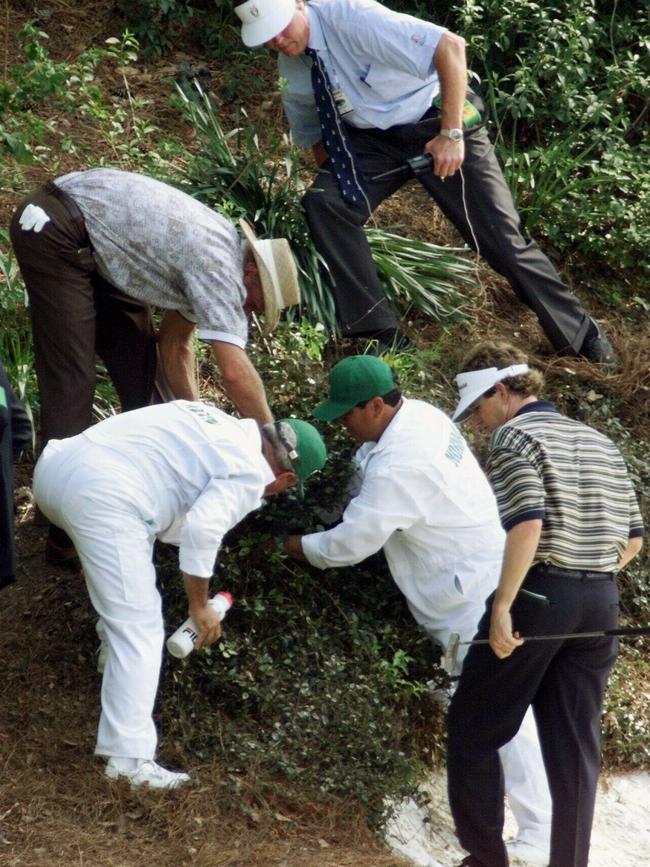Mona Lisa v the masters, for whom ‘Hell’s Bell’ tolls
The shortest hole at Augusta National is a work of art. Which is why it’s untouched in 90 years. It has slayed some of the game’s greatest and may do so forevermore.

Ken Done may have created the 12th hole with brush and canvas. Although I’m not sure there’s enough colours in his palette. Every tee box, fairway and green at Augusta National has been altered in some way, shape or form since the gates to this enchanted forest of a property opened in 1934 – except the vibrant, flamboyant 12th.
It’s a work of art. Untouched for 90 years. It looks like such a painting there’s real paintings of it in every corridor from the champions locker room to the public bars at the US Masters. The grandstand behind the tee is packed from dawn until dusk.
It’s a truly legendary, historic, magical, mystical, perplexing, hypnotising, magnificent hole, but Vijay Singh, who may be struck down by lightning the next time he crosses Hogan Bridge, reckons it needs to be toughened up.
Called “Golden Bell”, for the flowering yellow shrub behind the snooker-table green, it’s a 155-yard par three, about 142m in our money. The pros should eat it with their salmon bagels for breakfast, flicking a wedge to the clouds that hit and stick and offer gimme birdie putts all day long, and yet something happens down here in the Ken Done painting known as Amen Corner. Nerves start jangling on championship Sunday and witches cackle and balls trickle into Rae’s Creek or disappear into the thickets. Golden Hell.

“We used to hit seven-irons and six-irons and then it started going to seven-irons and eight-irons and it’s gone from eight-irons to nine-irons and the guys are hitting wedges now,” Singh says. “They should lengthen it by at least 10 yards. I think it should go to at least 170. I think it would be a much more challenging hole if people were hitting a six-iron or a seven-iron instead of a nine-iron or wedge.”
And yet Golden Bell subtly, quietly, consistently punches above its weight. The scoring average at the 2022 Masters was 3.233. Last year it was 3.058 with 49 birdies, 47 bogeys and nine double bogeys or worse. It stands alongside The Road Hole at St Andrews as the two most famous holes in the sport.
According to Augusta National chairman Fred S. Ridley, not a blade of grass nor grain of sand nor drop of water will ever be changed.
Not ever? “Well, ever is a long time,” Ridley says. “I would say with a hundred per cent certainty that it would not be lengthened during my tenure. That’s almost like asking, you know, can we touch up the Mona Lisa a little bit?”
Hell’s Bell sits in a natural amphitheatre. The front-side green looks like a smiley face. The green is shaped like a shoeprint. The Hogan and Nelson bridges frame it. Rae’s Creek reflects like a mirror. The meaning of life may be in it. “I’ve seen that hole cripple many a man,” three-time champion Gary Player says. Many a man.”
Jordan Spieth was crippled in 2016. Leading the tournament on the Sunday. Chasing back-to-back green jackets. Made a quadruple-bogey seven to bomb out. He hit one ball into Rae’s Creek, then another, and then another, and then he turned to caddie Michael Greller and said, “Buddy, it seems like we’re collapsing”. Many a man.

In his first official round at the course he created, Bobby Jones put his tee shot at 12 into Rae’s Creek. Arnold Palmer squandered the 1959 Masters when he put two balls in the water on Sunday.
He carded a triple-bogey six and lost from a five-shot lead. Jack Nicklaus hit a shank in 1964, bogeyed and finished second. Bubba Watson once took a 10. So did Tiger Woods in 2020 in his worst single-hole score as a professional. Many a man.
All those monster par fours and fives around the world, and Woods’ highest score is inside the Ken Done painting. Tee shot in the water. Penalty stroke. Pitch rolled back in the water. Penalty stroke. Pitch flew into the back bunker. Sand shot skidded across the green into the water. Penalty stroke. Sand shot stayed on the fringe like it was scared to enter the green. Two putts. Septuple bogey. Many a man.
“The possibility of such a huge discrepancy in score makes that hole so great,” says Phil Mickelson. “From a two to a 10, we have seen large numbers.” Another former champion, Bernhard Langer, adds, “By far the scariest shot on the course”. When famed Los Angeles Times columnist Jim Murray played the 12th he wrote: “Do I use a seven-iron here? Or a St Christopher medal? Help.”
It’s the littlest hole on the course. And the scariest. The most welcoming and the most intimidating. The most beautiful and the most brutal.
A yarn in the San Diego Union-Tribune suggests: “If Augusta National is golf’s cathedral, this is its Sistine Chapel. Michaelangelo painted the ceiling in Rome; God splashed colour on the backdrop at 12, azaleas and camellias and dogwoods and magnolias mixed with a burnt red Japanese maple tree.”
Craig Parry might have won the 1992 Masters if the 12th was kinder to him. Or less generous to Fred Couples.

The American’s eight-iron hit the bank in front of the green. Nine times out of 10, heck, 99 times out of 100, the ball would dribble back into the drink. It stayed dry. Popeye was fading fast, Couples bunted home a par and went on to win.
Ridley won’t touch the Mona Lisa. “There’s something about it – I don’t know what it is, but there’s something about the topography, the trees, the wind, the beauty that just … it just captures your imagination. When you combine that with the history that’s been made there.”
Such as? “I mean, the most recent being the tragedies and triumphs when Tiger Woods won in 2019,” Ridley says. “You know, Freddie Couples’ ball, you know, hanging up on the edge of Rae’s Creek, which is part of the song of Augusta. I just think it’s such an iconic hole that’s had so many important moments in the Masters that I’m not sure another 10 yards would really make a difference.
“Players are hitting short irons but it doesn’t seem to matter. The hole is very difficult. I mean, the 12th hole at Augusta is the most iconic par three in the world. I think it always will be.”


To join the conversation, please log in. Don't have an account? Register
Join the conversation, you are commenting as Logout